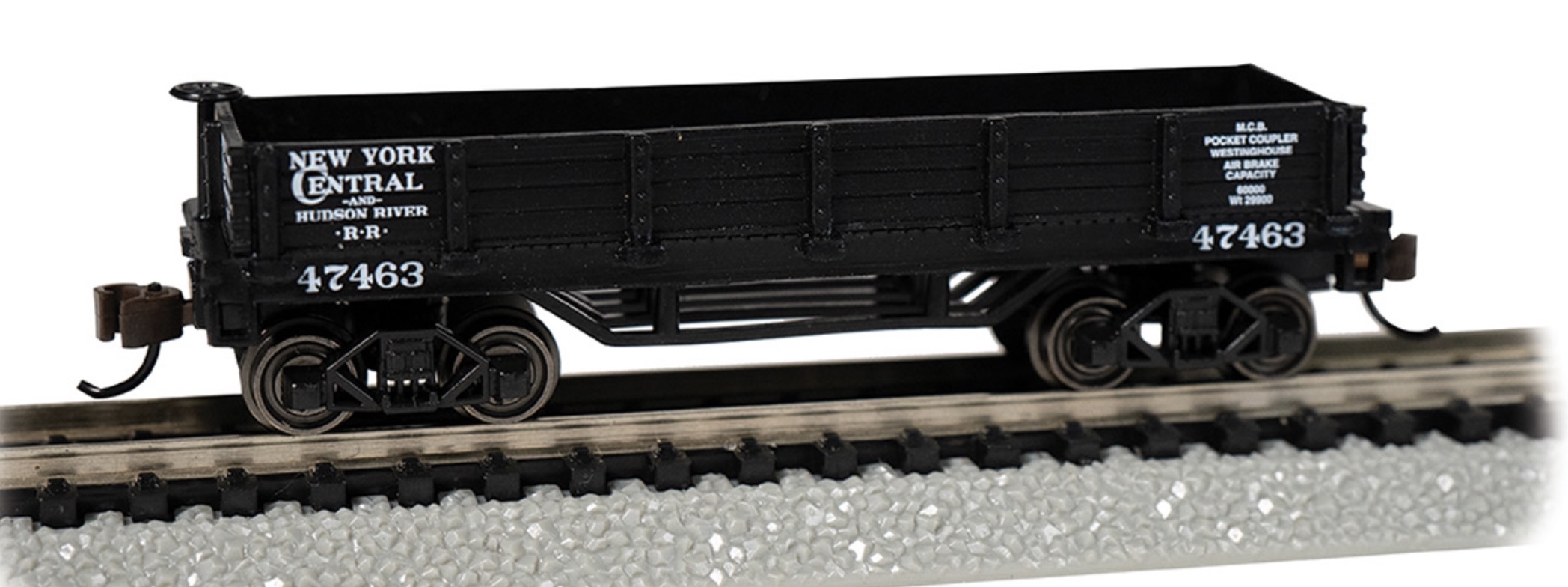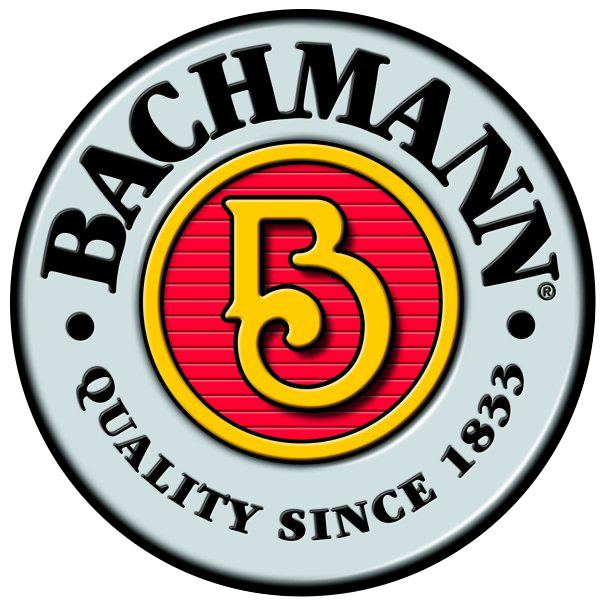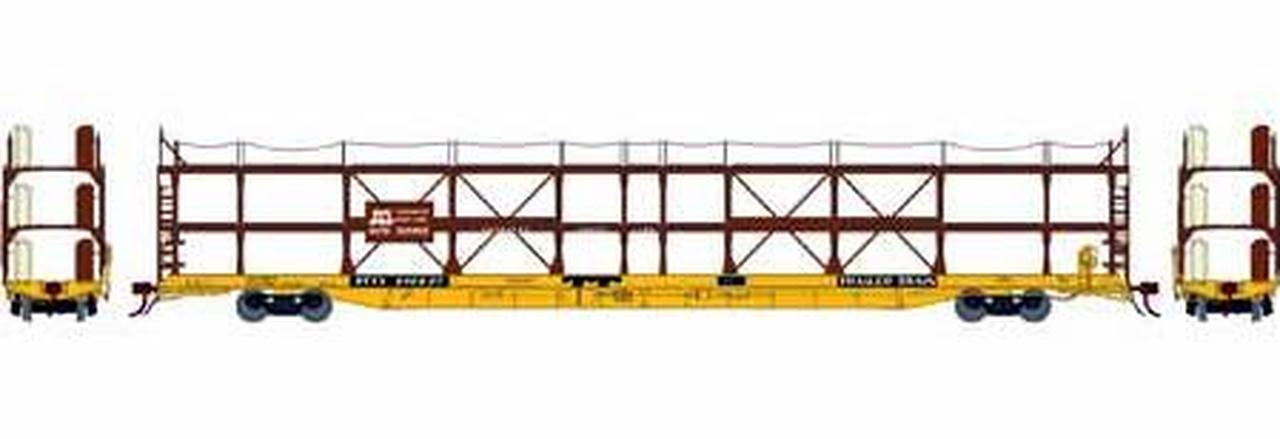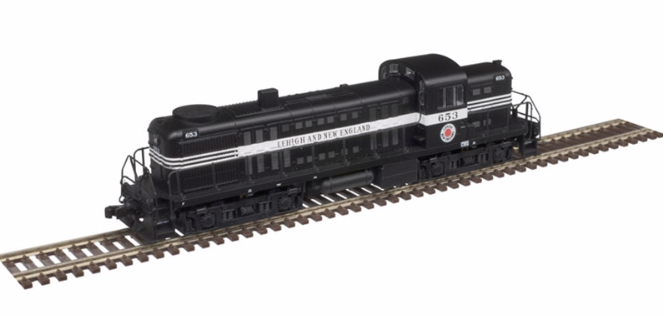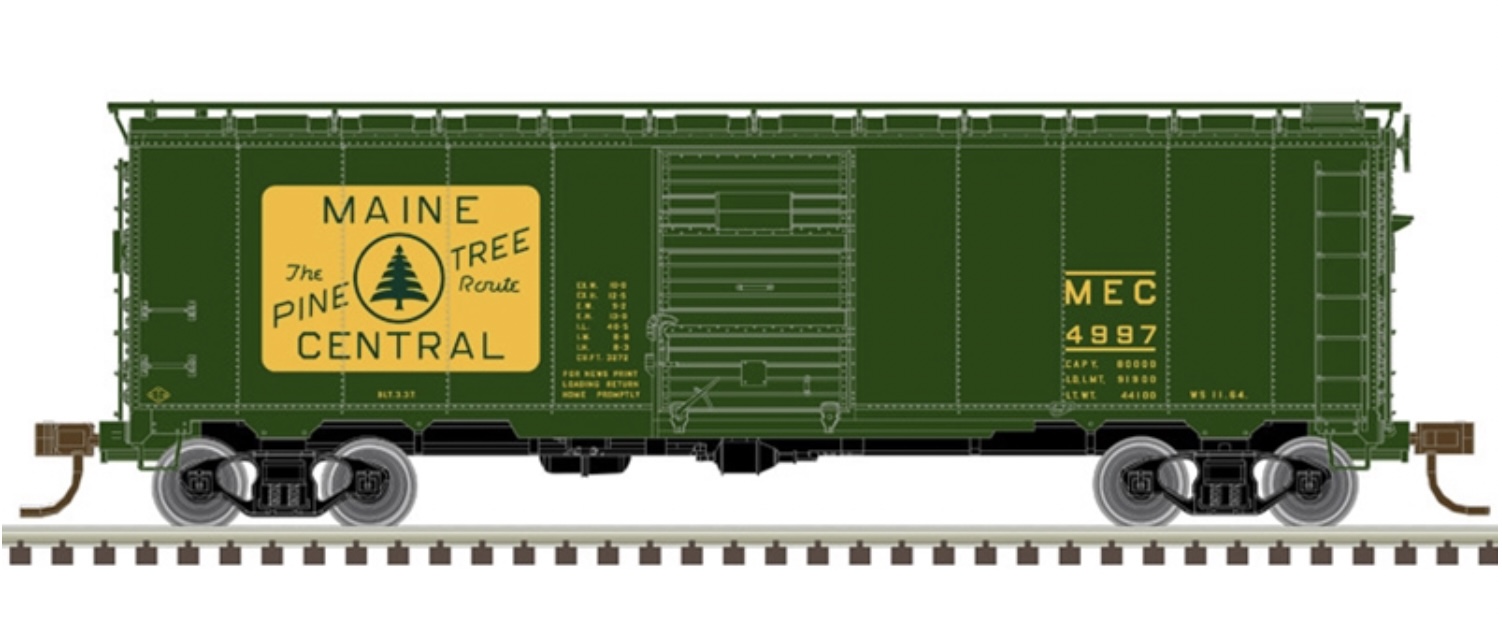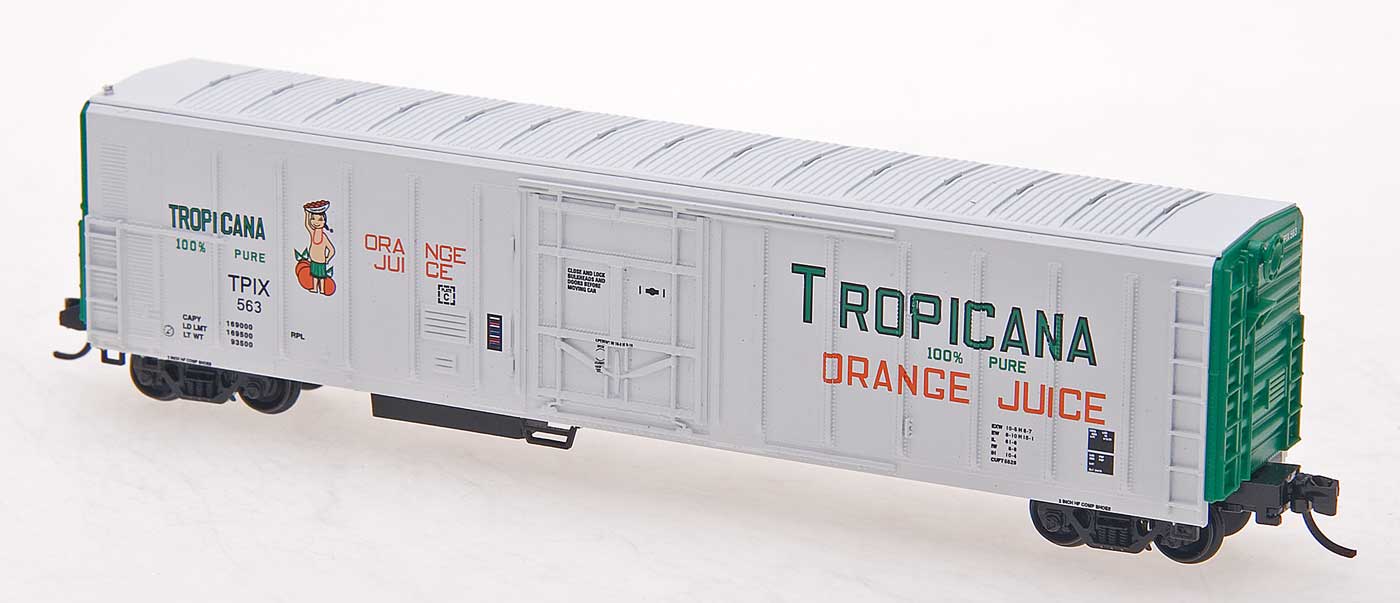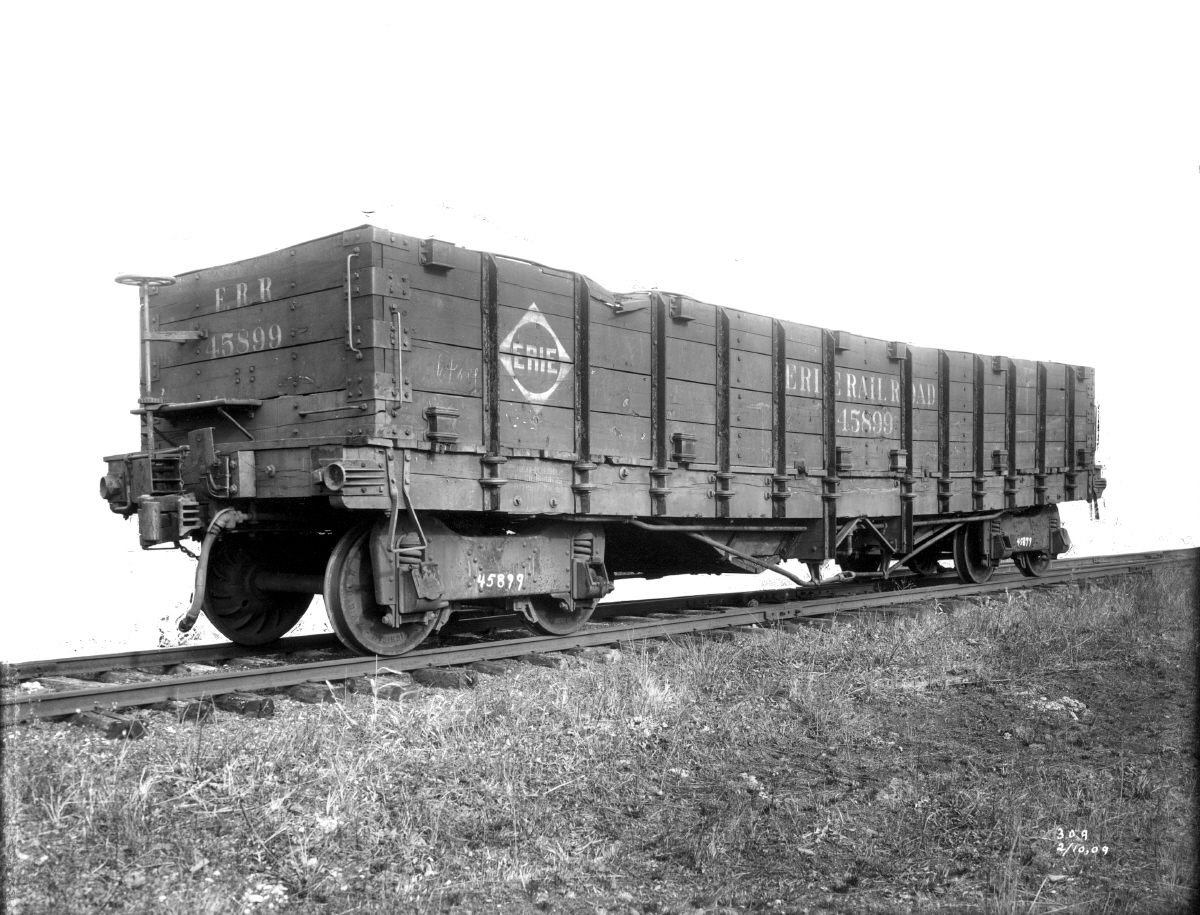Bachmann - 15456 - Gondola, Early, Wooden - New York Central & Hudson River - 47463
| Stock Number | 15456 |
| Original Retail Price | $32.00 |
| Brand | Bachmann |
| Manufacturer | Bachmann |
| Body Style | Bachmann Gondola 34 Foot Wood |
| Prototype Vehicle | Gondola, Early, Wooden (Details) |
| Road or Company Name | New York Central & Hudson River (Details) |
| Road or Reporting Number | 47463 |
| Paint Color(s) | Black |
| Print Color(s) | White |
| Coupler Type | E-Z Mate Mark II Magnetic Knuckle |
| Coupler Mount | Body-Mount |
| Wheel Type | Chemically Blackened Metal |
| Wheel Profile | Small Flange (Low Profile) |
| Release Date | 2022-01-01 |
| Item Category | Rolling Stock (Freight) |
| Model Type | Gondola |
| Model Subtype | Old Time |
| Model Variety | Wooden |
| Prototype Region | North America |
| Prototype Era | NA Era I: Early Steam (1835 - 1900) |
| Scale | 1/160 |
Prototype History:
In US railroad terminology, a gondola is an open-topped rail vehicle used for transporting loose bulk materials. Because of their low side walls gondolas are also suitable for the carriage of such high-density cargos as steel plates or coils, or of bulky items such as prefabricated sections of rail track.
Road Name History:
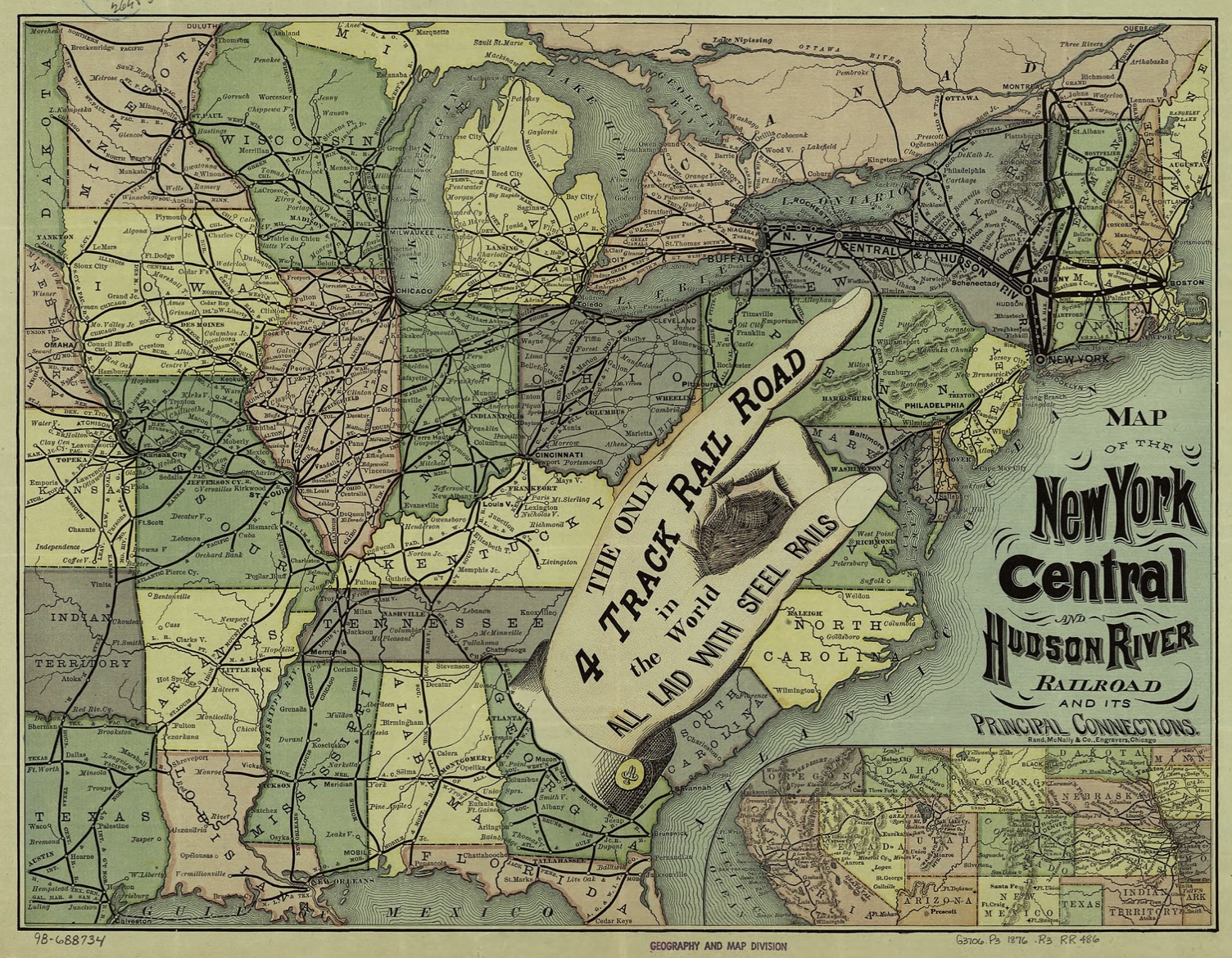 In 1867, Cornelius Vanderbilt acquired control of the Albany to Buffalo-running NYC, with the help of maneuverings related to the Hudson River Bridge in Albany. On November 1, 1869, he merged the NYC with his Hudson River Railroad to form the New York Central and Hudson River Railroad. This extended the system south from Albany along the east bank of the Hudson River to New York City, with the leased Troy and Greenbush Railroad running from Albany north to Troy.
In 1867, Cornelius Vanderbilt acquired control of the Albany to Buffalo-running NYC, with the help of maneuverings related to the Hudson River Bridge in Albany. On November 1, 1869, he merged the NYC with his Hudson River Railroad to form the New York Central and Hudson River Railroad. This extended the system south from Albany along the east bank of the Hudson River to New York City, with the leased Troy and Greenbush Railroad running from Albany north to Troy.
Vanderbilt's other lines were operated as part of the NYC; these included the New York and Harlem Railroad, Lake Shore and Michigan Southern Railway, Canada Southern Railway and Michigan Central Railroad.
The Spuyten Duyvil and Port Morris Railroad was chartered in 1869 and opened in 1871, providing a route on the north side of the Harlem River for trains along the Hudson River to head southeast to the New York and Harlem Railroad. Trains could head toward Grand Central Depot, built by NYC and opened in 1871, or to the freight facilities at Port Morris. From opening, it was leased by the NYC.
The Geneva and Lyons Railroad was organized in 1877 and opened in 1878, leased by the NYC from opening. This was a connection between Syracuse and Rochester, running from the main line at Lyons to the Auburn Road at Geneva. It was merged into the NYC in 1890.
In 1885, the New York, West Shore and Buffalo Railway, a competitor since 1883 with trackage along the west shore of the Hudson River and on to Buffalo closely paralleling the NYC, was taken over by the NYC as the West Shore Railroad and developed passenger, freight, and car float operations at Weehawken Terminal. The NYC assumed control of the Pittsburgh and Lake Erie and Boston and Albany Railroads in 1887 and 1900, respectively, with both roads remaining as independently-operating subsidiaries. William H. Newman, president of the New York Central lines, resigned in 1909. Newman had been president since 1901, when he replaced Samuel R. Callaway (who had replaced Depew as president in 1898).
In 1914, the operations of eleven subsidiaries were merged with the New York Central & Hudson River Railroad, re-forming the New York Central Railroad. From the beginning of the merger, the railroad was publicly referred to as the New York Central Lines. In the summer of 1935, the identification was changed to the New York Central System, that name being kept until the merger with the Pennsylvania Railroad in 1968..From Wikipedia

Vanderbilt's other lines were operated as part of the NYC; these included the New York and Harlem Railroad, Lake Shore and Michigan Southern Railway, Canada Southern Railway and Michigan Central Railroad.
The Spuyten Duyvil and Port Morris Railroad was chartered in 1869 and opened in 1871, providing a route on the north side of the Harlem River for trains along the Hudson River to head southeast to the New York and Harlem Railroad. Trains could head toward Grand Central Depot, built by NYC and opened in 1871, or to the freight facilities at Port Morris. From opening, it was leased by the NYC.
The Geneva and Lyons Railroad was organized in 1877 and opened in 1878, leased by the NYC from opening. This was a connection between Syracuse and Rochester, running from the main line at Lyons to the Auburn Road at Geneva. It was merged into the NYC in 1890.
In 1885, the New York, West Shore and Buffalo Railway, a competitor since 1883 with trackage along the west shore of the Hudson River and on to Buffalo closely paralleling the NYC, was taken over by the NYC as the West Shore Railroad and developed passenger, freight, and car float operations at Weehawken Terminal. The NYC assumed control of the Pittsburgh and Lake Erie and Boston and Albany Railroads in 1887 and 1900, respectively, with both roads remaining as independently-operating subsidiaries. William H. Newman, president of the New York Central lines, resigned in 1909. Newman had been president since 1901, when he replaced Samuel R. Callaway (who had replaced Depew as president in 1898).
In 1914, the operations of eleven subsidiaries were merged with the New York Central & Hudson River Railroad, re-forming the New York Central Railroad. From the beginning of the merger, the railroad was publicly referred to as the New York Central Lines. In the summer of 1935, the identification was changed to the New York Central System, that name being kept until the merger with the Pennsylvania Railroad in 1968..From Wikipedia
Brand/Importer Information:
Bachmann Industries (Bachmann Brothers, Inc.) is a Bermuda registered Chinese owned company, globally headquartered in Hong Kong; specializing in model railroading.
Founded in Philadelphia, Pennsylvania, the home of its North American headquarters, Bachmann is today part of the Kader group, who model products are made at a Chinese Government joint-venture plant in Dongguan, China. Bachmann's brand is the largest seller, in terms of volume, of model trains in the world. Bachmann primarily specializes in entry level train sets, and premium offerings in many scales. The Spectrum line is the high quality, model railroad product line, offered in N, HO, Large Scale, On30, and Williams O gauge all aimed for the hobbyist market. Bachmann is the producer of the famous railroad village product line known as "Plasticville." The turnover for Bachmann model trains for the year ended 31 December 2006 was approximately $46.87 million, a slight increase of 3.36% as compared to 2005.
Founded in Philadelphia, Pennsylvania, the home of its North American headquarters, Bachmann is today part of the Kader group, who model products are made at a Chinese Government joint-venture plant in Dongguan, China. Bachmann's brand is the largest seller, in terms of volume, of model trains in the world. Bachmann primarily specializes in entry level train sets, and premium offerings in many scales. The Spectrum line is the high quality, model railroad product line, offered in N, HO, Large Scale, On30, and Williams O gauge all aimed for the hobbyist market. Bachmann is the producer of the famous railroad village product line known as "Plasticville." The turnover for Bachmann model trains for the year ended 31 December 2006 was approximately $46.87 million, a slight increase of 3.36% as compared to 2005.
Item created by: CNW400
on 2022-05-05 12:55:40
Last edited by: CNW400 on 2022-05-05 12:55:41
If you see errors or missing data in this entry, please feel free to log in and edit it. Anyone with a Gmail account can log in instantly.
Last edited by: CNW400 on 2022-05-05 12:55:41
If you see errors or missing data in this entry, please feel free to log in and edit it. Anyone with a Gmail account can log in instantly.


